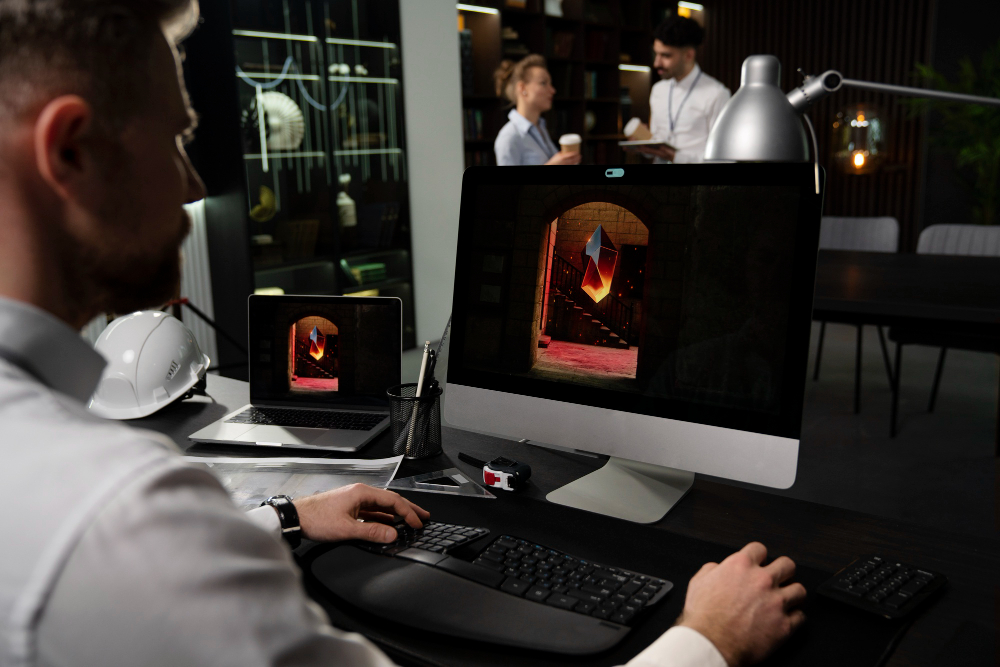Deep learning is what supports modern artificial intelligence and helps deliver breakthroughs in areas ranging from natural language processing to computer vision and autonomous driving, among others.
Such breakthroughs are impossible without the deep learning frameworks that allow developers to design, train, and deploy complex neural networks.
Among the most widely used domains, TensorFlow and PyTorch have been quite a hit.
Both TensorFlow and PyTorch have been gaining popularity among researchers and working professionals very rapidly due to their strength and the extensive communities behind them.
However, it can be tough to decide between these two for the new people moving into deep learning.
In this article, we try to provide a comparative synopsis of TensorFlow and PyTorch regarding their key features and differences, performance, and use cases.
Read on to find out which may suit your needs better by the end of it.
Introduction to TensorFlow
History and Development of TensorFlow in Brief
TensorFlow was created by the Google Brain team and first published as an open-source project in 2015.
It was created with the mission of making it easier for developers and researchers to build, train, and deploy machine learning models efficiently.
Since its publication, TensorFlow has emerged as one of the most popular deep learning frameworks due to a strong ecosystem, vast and extensive documentation,, large scale models and support for vast platforms such as cloud services.
Key Features and Components
1. Tensors and Computational Graphs:
• TensorFlow is constructed around tensors, multi-dimensional arrays from which all data in TensorFlow is derived.
• Static computational graphs are used; that is, you build a complete dynamic computational graph first before running. This has advantages in parallelizing execution and memory use.
2. TensorFlow Extended (TFX):
• TensorFlow Extended (TFX): It is an end-to-end platform for deploying the production ML pipelines. It includes tools for data validation, and model development, building, training, serving, and even monitoring.
3. TensorFlow Lite:
• It has optimized performance for a lower-resource environment to be deployed onto mobile and embedded devices.

Use Cases and Applications
TensorFlow is one of the leading applied ML platforms in healthcare, finance, and robotics applications. Some of the most dominated operations are:
•Image classification (example: disease detection from medical images)
• Natural language processing applications: sentiment analysis, and machine learning applications, translation
• Reinforcement learning (self-driving, robots, artificial intelligence)
Overview of PyTorch
Brief History and Development of PyTorch
PyTorch was developed by the AI Research lab of Facebook (FAIR) and was released in 2016.
It has been adopted fast due to its user-friendliness, dynamic nature of the computational graphs and strong support for GPU acceleration.
Contrasted with TensorFlow, which initially used a static graph, PyTorch took a more flexible way of using programming languages based on Python, which researchers and developers prefer because it better expresses their intuition and nature.
Key Features and Components
1. Dynamic Computation Graphs (Define-by-Run):
• PyTorch, instead, utilizes dynamic computation graphs and is thus known as "define-by-run." It means you can build and modify a computational or dynamic computation graph on the fly. This makes it easier to debug and experiment with different models.
2. Strong Support for GPU Acceleration:
• PyTorch has good use of GPUs, for example. So, this framework is well suitable for training large neural networks. It integrates very nicely with CUDA, in the case of NVIDIA GPUs, and can handle very efficient computation
3. PyTorch Lightning:
• It is a lightweight wrapper around PyTorch. It simplifies both model development and the training process by organizing code, reducing boilerplate, and simplifying the implementation of advanced features like distributed training and precision scaling.

Use Cases and Applications
• PyTorch is very popular in the research community for the ease with which it allows developers to write code and experiment with their model design. Some of the most common applications are:
• Computer vision (object detection, generative adversarial training neural networks only)
• Speech recognition (transcribing spoken language)
• Reinforcement to train deep learning models (game AI, robotics)
Key Differences Between TensorFlow and PyTorch
1. Computation Graphs: Static vs. Dynamic
• TensorFlow relies on static computation graphs - computation graphs which have to be determined fully before runtime.
In the case of model use in production, it's especially helpful for optimization and performance.
• PyTorch uses dynamic computation graphs, which lets users build graphs on the fly during runtime and modify them in real time.
This feature is very valuable for research and development because building and debugging are more intuitive in iterative development.
• TensorFlow's static graphs are more suitable for large-scale production environments, whereas PyTorch's dynamic graph favors rapid prototyping and research.
2. Ease of Use
• Initially, TensorFlow was a tougher nut to crack since its awkward API and static graph system kept it somewhat clunky.
All that changed with the introduction of Keras as its high-level API. Now, with Keras, TensorFlow becomes easy to use.
• PyTorch: This is arguably the easiest to use and is usually preferred by new beginners because it is simple and Pythonic.
It's also favorably known for clear, concise syntax as well as an intuitive debugging process, which makes it a big favorite among researchers.

3. Model Deployment
• TensorFlow has many options: there's TensorFlow Serving, the way to serve neural network models in production, TensorFlow Lite, the way to run machine learning models even on mobile devices, and TensorFlow.js, allowing one to run models and do other deep learning frameworks in web applications.
• PyTorch has TorchServe to serve models and also allows export to ONNX format, so you can deploy models on diverse platforms.
4. Community and Ecosystem
• TensorFlow has a more significant, community support, and ecosystem; here, you have many pre-trained models, libraries, and much more in resource availability with TensorFlow Hub.
• PyTorch is accelerating more in academic areas; research communities are continually supporting it, and resources like PyTorch Hub aid its usage.

5. Performance and Scalability
Training Speeds and Resource Efficiency
Both frameworks suit well for GPU acceleration support, but what the actual performance is depends on your actual use case.
• TensorFlow does better in a production setting, given the benefits of static graph execution optimization.
• PyTorch can give better times to iterate over designs and developments since it allows for dynamic graph capabilities.
Support for Distributed Training
• TensorFlow: It does have strong support for distributed training through tf.distribute.Strategy, which makes scaling out to multiple GPUs or machines very easy.
• PyTorch: Supports distributed training and offers utilities like torch distributed as well as both PyTorch and Lightning, which makes that type of thing very simple to achieve.
6. Famous Libraries and Tools
TensorFlow Ecosystem
1. Keras: High-level API, making it simpler to build and train models.
2. TensorBoard: A visualization tool, designed to help see how the training process is going, performing, and doing, so so much more.
PyTorch Ecosystem
1. Fastai: Built on top of PyTorch, this library simplifies training models with state-of-the-art techniques.
2. PyTorch Hub: A repository of pre-trained models that can be easily integrated into your projects.
Case Studies and Real-World Applications

Successful Projects Using TensorFlow
• Google Translate: TensorFlow powers the deep learning models behind Google's translation service.
• Airbnb: Uses TensorFlow for various tasks, including image categorization and personalized search results.
Successful Projects Using PyTorch
• Tesla's Autopilot: PyTorch is applied in all Tesla's self-driving car AI systems.
• Facebook's AI Research: Most Facebook's AI projects, such as language translations and computer vision, use PyTorch.
Industry Trends
• TensorFlow: remains more dominant in enterprise environments due to its mature ecosystem and production-readiness.
• PyTorch: appears lately to be rapidly growing in popularity in the research community and academia nowadays primarily because of its flexibility and ease of use.
Challenges and Limitations
Common Issues Encountered by TensorFlow Users
• Complexity: TensorFlow's static graph model is quite complex and challenging to debug for new users.
• Steep Learning Curve: Even though this has been decreasing with every version, some find TensorFlow's API more awkward than both PyTorch and.
Common Issues Encountered by PyTorch Users
• Fewer Choices of Deployment Options: While it truly stands out for research, in the past, PyTorch had far fewer deployment tools than TensorFlow, although this is quickly diminishing with tools like TorchServe.
• Less Mature Ecosystem: Although PyTorch is developing fast, it is much less mature than TensorFlow, especially in terms of production tools.
Trends in Deep Learning Frameworks for the Future

Predictions about Future Evolution for TensorFlow and PyTorch
- TensorFlow probably continues the trend of slow evolution towards ease of use and readiness for production by adding more tools in the style of TFX and TensorFlow Lite.
PyTorch will gain further repute in terms of deployment and scalability and could be a major player in the production deployment.
Emerging Trends
AutoML and Federated Learning are the axes where the future of deep learning frameworks is being shaped and molded.
TensorFlow and PyTorch are quite extensively working on the directions of AutoML and Federated Learning to make way for more and more automated and privacy-preserving AI systems.

In summary, what we think
Such open source contributions were critical to the growth of both frameworks.
Active communities around TensorFlow and PyTorch are what keep these two at the top of deep and machine learning research work.
Both TensorFlow and PyTorch have very high strengths and weaknesses.
TensorFlow significantly wins in terms of production environments, with a strong set of deployment tools.
On the other hand, due to dynamic computation graphs and intuitive design, PyTorch will always lead in research and experimentation.
• Choose TensorFlow: if you need a mature, production-ready platform with deep learning framework extensive deployment capabilities.
• Opt for PyTorch: if you are flexible, it uses easy and focuses more on research and prototyping.
In the end, the only way to really understand both of these frameworks would be to experiment with both.
With experimentation with building complex neural networks models, you will learn about complex models and their possibilities and make better decisions about your particular deep learning projects.

Incentivizing Exploration in Both Frameworks
Whether you're new or just a keen enthusiast in deep learning, both TensorFlow and PyTorch offer great insights into AI.
Meanwhile, both offer much; knowing their differences will prepare you to attack a huge range of challenges the deep learning framework has to give.